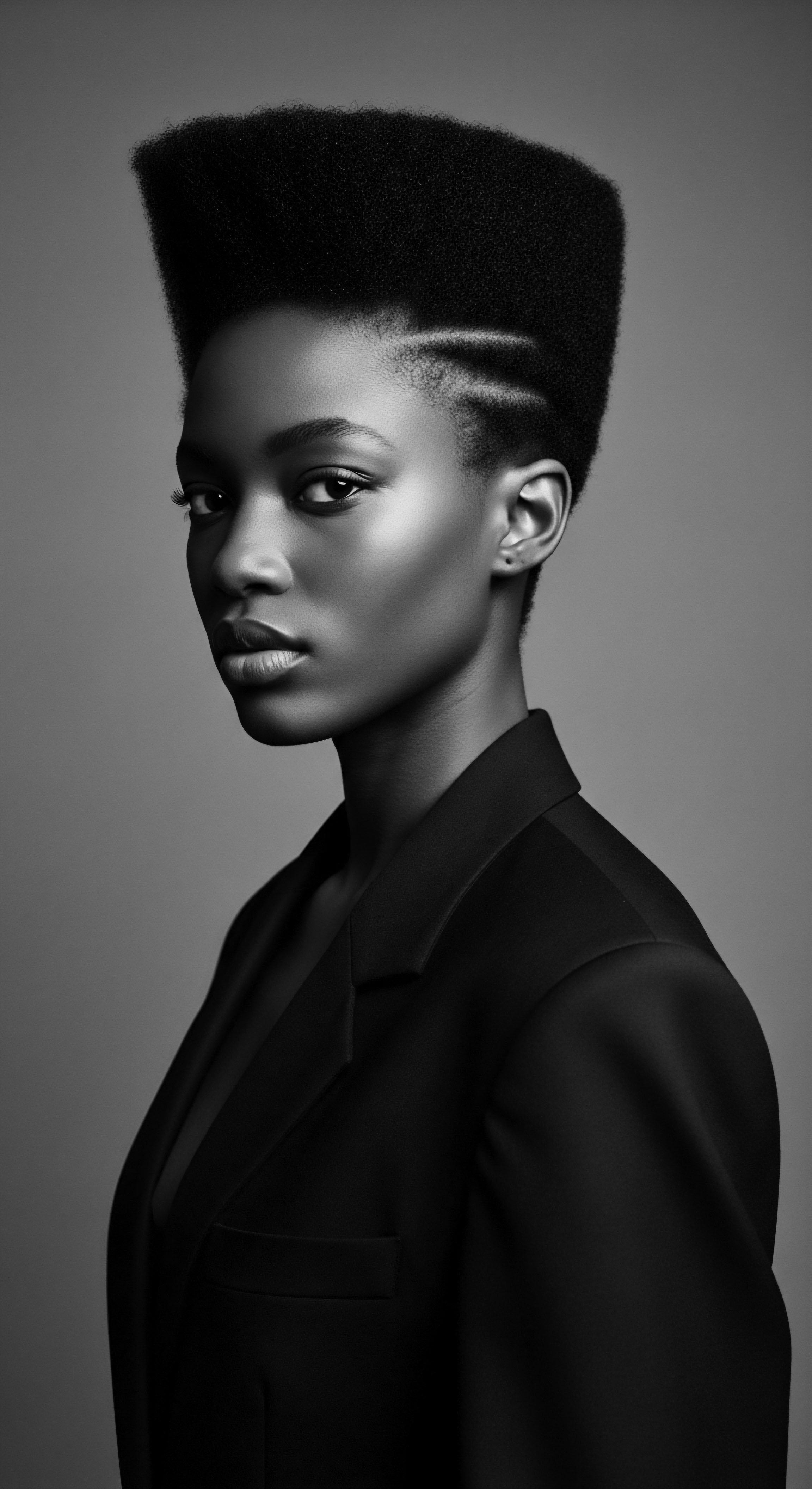
Fundamentals
The phrase ‘Plant-Based Scalp Care’ refers to the intentional application of botanically derived ingredients and preparations to the scalp, aimed at maintaining its health, fostering an optimal environment for hair growth, and addressing various concerns. This approach draws upon the inherent biological properties of plants—their oils, extracts, powders, and infusions—to nourish, soothe, cleanse, and protect the scalp. It is a practice deeply rooted in the wisdom of ancestral traditions across the globe, particularly those communities where hair has always been revered as a symbol of identity, status, and spiritual connection. For individuals with textured hair, especially those within Black and mixed-race communities, this form of care carries a particular significance, often echoing generational practices that predate modern cosmetic formulations.
At its core, Plant-Based Scalp Care is a gentle conversation with the earth, a recognition that the vitality of our strands begins at the very source—the scalp. This approach honors the symbiotic relationship between plant life and human well-being, emphasizing sustainability and a mindful connection to nature. It moves beyond superficial cosmetic solutions, seeking to establish a balanced and thriving scalp ecosystem through natural means.

The Elemental Foundations of Care
Understanding Plant-Based Scalp Care begins with recognizing the fundamental components it employs. These are not merely ingredients; they are botanical allies, each with its own unique story and efficacy, often passed down through oral traditions and communal practices.
- Botanical Oils ❉ These are the liquid gold of scalp care, extracted from seeds, nuts, and fruits. Oils such as Coconut Oil, Jojoba Oil, and Castor Oil have been utilized for centuries to moisturize, condition, and protect the scalp and hair. They serve as carriers for other beneficial compounds, aiding in the delivery of nutrients to the hair follicles.
- Herbal Infusions and Extracts ❉ The leaves, roots, and flowers of various plants yield potent extracts and infusions. Think of rosemary, peppermint, or hibiscus. These botanical allies are rich in antioxidants, anti-inflammatory compounds, and circulation-stimulating properties, all of which contribute to a healthy scalp environment. Studies indicate that plant extracts can support hair growth by stimulating hair follicles and improving scalp circulation.
- Clays and Powders ❉ Earth-derived clays like rhassoul, alongside finely ground plant powders such as fenugreek or amla, offer cleansing, detoxifying, and conditioning benefits. These ingredients absorb impurities, balance oil production, and deliver minerals directly to the scalp, often without stripping its natural moisture.
The application of these elements often involves rituals that extend beyond mere function, becoming acts of self-care and community bonding.

A Gentle Overview of Application
The methods of applying plant-based remedies to the scalp are as diverse as the plants themselves, yet they often share a common thread of mindful, hands-on engagement.
- Scalp Oiling ❉ This involves massaging botanical oils, sometimes infused with herbs, directly into the scalp. This practice, known as Shiro Abhyanga in Ayurvedic tradition, stimulates blood flow and deeply moisturizes the skin, promoting a healthy foundation for hair.
- Herbal Rinses and Washes ❉ Infusions from herbs are used as final rinses after cleansing, or as gentle cleansers themselves. These can help to balance the scalp’s pH, soothe irritation, and impart natural conditioning.
- Masks and Treatments ❉ Blends of clays, powders, and liquids are applied as masks, allowing the scalp to absorb their therapeutic properties over a longer period. These are often used for targeted concerns such as dryness, flakiness, or excess oil.
This initial understanding sets the stage for a deeper exploration into the historical resonance and scientific underpinnings of Plant-Based Scalp Care, particularly for those whose hair carries the echoes of a rich and resilient heritage.

Intermediate
Moving beyond the foundational comprehension, the intermediate meaning of Plant-Based Scalp Care delves into its profound historical roots and the intricate ways it has sustained textured hair across generations and geographies. This is where the simple definition blossoms into a vibrant understanding of its cultural weight and ancestral significance. For Black and mixed-race communities, hair has never been a mere aesthetic concern; it has served as a profound marker of identity, spirituality, social status, and even resistance. Plant-based scalp care, in this context, is not just a regimen; it is a living archive of resilience and self-preservation.

Echoes from the Source ❉ Ancestral Wisdom in Action
The practices of Plant-Based Scalp Care are not recent inventions; they are enduring traditions, passed down through the ages, particularly within African cultures where hair was revered. In pre-colonial Africa, hairstyles communicated status, age, ethnic identity, and spiritual beliefs. The meticulous care of hair, including the scalp, was an integral part of these communal and individual expressions.
The ancestral knowledge embedded within plant-based scalp care represents a continuous dialogue between the wisdom of the earth and the enduring spirit of textured hair heritage.
Consider the use of shea butter, a cornerstone of West African hair care. Derived from the nuts of the shea tree, its emollient properties have provided deep moisture and protection for coils and kinks for centuries. Similarly, coconut oil, prevalent in many African and diasporic communities, has been a staple for nourishing both hair and scalp. These are not isolated instances; they are testament to a sophisticated understanding of botanical efficacy long before the advent of modern chemistry.

The Tender Thread ❉ Communal Rituals and Intergenerational Learning
The application of these plant-based remedies often occurred within communal settings, transforming routine care into cherished social rituals. Mothers, daughters, and friends would gather, braiding hair, sharing stories, and imparting wisdom about specific plants and their uses. This collective experience reinforced cultural bonds and ensured the transmission of knowledge across generations. The very act of caring for hair with plant-based ingredients became a tender thread connecting individuals to their lineage and community.
During the horrific era of transatlantic slavery, when enslaved Africans were forcibly stripped of their cultural identifiers, including their hair practices, the resilience of these plant-based traditions persisted. Despite immense oppression, women would often braid seeds into their hair as a means of survival and to preserve their cultural heritage, using available natural resources for rudimentary care. This period saw the adaptation of traditional knowledge to new environments, showcasing the incredible ingenuity and determination to maintain a connection to ancestral ways.
| Traditional Practice/Ingredient Chebe Powder (Croton zambesicus) |
| Cultural Origin/Context Basara women of Chad, Central Africa. Used for centuries to retain hair length and moisture. |
| Contemporary Application/Benefit Modern natural hair community uses for strengthening strands, reducing breakage, and promoting moisture retention in textured hair. |
| Traditional Practice/Ingredient African Black Soap (Plantain skin ash, cocoa pods, shea butter) |
| Cultural Origin/Context West Africa, particularly Ghana and Nigeria. Used for cleansing skin and hair. |
| Contemporary Application/Benefit Gentle, purifying cleanser for scalp and hair, known for antibacterial and exfoliating properties, beneficial for dandruff and scalp irritation. |
| Traditional Practice/Ingredient Scalp Oiling with Botanical Blends (e.g. Shea butter, Coconut oil) |
| Cultural Origin/Context Widespread across various African communities and the diaspora for nourishment and protection. |
| Contemporary Application/Benefit Hydrates dry scalps, reduces flakiness, improves circulation, and creates a healthy environment for hair growth in curly and coily textures. |
| Traditional Practice/Ingredient Buchu Oil (Agathosma betulina) |
| Cultural Origin/Context Indigenous Khoisan people of South Africa, revered for medicinal properties. |
| Contemporary Application/Benefit Used in modern scalp care for its antimicrobial and anti-inflammatory benefits, addressing issues like dandruff and itchy scalp. |
| Traditional Practice/Ingredient These examples illuminate the unbroken lineage of plant wisdom, adapting and persisting through time to serve the unique needs of textured hair. |

The Unbound Helix ❉ Modern Science Affirming Ancient Paths
Today, modern scientific inquiry often validates the long-standing efficacy of these ancestral practices. What was once understood through generations of observation and experiential knowledge is now being elucidated at a biochemical level. For instance, the traditional use of plant extracts like rosemary for scalp stimulation and hair growth finds support in studies showing its ability to improve circulation and promote hair follicle health. Similarly, the use of certain plant oils to maintain scalp health aligns with scientific understanding of their fatty acid profiles and antimicrobial properties.
The hair shaft of Afro-textured hair, characterized by its elliptical shape and tightly coiled structure, is inherently more prone to dryness and breakage compared to other hair types. This unique biological reality underscores the historical reliance on deeply moisturizing and protective plant-based ingredients. The ancestral practices of consistent oiling and gentle handling, often facilitated by these natural emollients, directly addressed these specific needs, minimizing tension and promoting hydration.
The journey of Plant-Based Scalp Care is a testament to the profound ingenuity of ancestral communities, whose empirical wisdom now finds resonant validation in the corridors of contemporary scientific understanding.
The contemporary understanding of Plant-Based Scalp Care for textured hair is therefore a beautiful confluence of past and present. It recognizes the profound cultural significance of these practices, the communal bonds they fostered, and the inherent biological suitability of plants for the unique needs of coils and kinks. It is a celebration of a heritage that continues to inform and enrich our approach to hair wellness.

Academic
The academic definition of Plant-Based Scalp Care, particularly within the context of Textured Hair Heritage, transcends a mere catalog of ingredients or practices; it represents a sophisticated convergence of ethnobotany, dermatological science, cultural anthropology, and historical sociology. This interdisciplinary perspective reveals Plant-Based Scalp Care as a dynamic system of care, deeply embedded in the ontological and epistemological frameworks of Black and mixed-race communities, where the scalp is not merely a biological surface but a site of ancestral memory, identity assertion, and communal well-being. Its meaning is a profound explication of how specific botanical interventions, rooted in millennia of empirical observation, interact with the unique physiological architecture of textured hair follicles and the psychosocial dimensions of hair in diasporic contexts.
The scholarly interpretation of Plant-Based Scalp Care delineates its role as a bio-cultural phenomenon. It acknowledges that the efficacy of these botanical applications is not solely attributable to their isolated phytochemical properties but also to the ritualized contexts, communal knowledge transfer, and the profound symbolic significance ascribed to them within specific cultural matrices. This approach demands a rigorous examination of both the intrinsic biological mechanisms of plant compounds and the extrinsic socio-historical forces that have shaped their use and perception.

The Biogeographical Tapestry of Ancestral Care
The historical development of Plant-Based Scalp Care for textured hair is inextricably linked to the diverse biogeographical landscapes of Africa and the subsequent adaptations within the diaspora. Prior to the transatlantic slave trade, African societies possessed a sophisticated understanding of local flora for medicinal and cosmetic purposes. Hair and scalp care were integral to personal and communal identity, with specific plants used for cleansing, conditioning, stimulating growth, and treating various scalp conditions.
Consider the Chebe powder tradition of the Basara women in Chad, Central Africa. This indigenous practice, documented by anthropological studies from the University of Cairo, reveals a remarkable example of sustained hair length and health despite harsh environmental conditions (WholEmollient, 2025). The powder, primarily derived from the Croton zambesicus plant, is traditionally mixed with oils and applied to the hair shafts (avoiding the scalp to prevent buildup), forming a protective barrier that reduces breakage and enhances moisture retention.
This empirical knowledge, passed down through at least 500 years of oral tradition, underscores a deep, generations-long understanding of textured hair’s specific needs for moisture and protection. The mechanism here is not merely about direct follicular stimulation but about creating an external environment that minimizes mechanical stress and preserves the integrity of the hair strand, thereby promoting length retention, a critical concern for coily hair types prone to shrinkage and breakage.
This historical example serves as a powerful illumination of Plant-Based Scalp Care’s connection to textured hair heritage. The Basara women’s tradition is a testament to an ancestral practice that empirically solved a challenge inherent to Afro-textured hair—its propensity for dryness and breakage—long before modern trichology offered its explanations. Their methods, centered on localized botanical resources, were not just cosmetic but deeply integrated into a holistic approach to hair wellness and identity.

Phytochemical Efficacy and Hair Follicle Dynamics
From a scientific standpoint, the efficacy of plant-based ingredients in scalp care can be elucidated through their diverse phytochemical profiles. These compounds interact with the complex biology of the scalp and hair follicle unit.
- Anti-Inflammatory Agents ❉ Many plant extracts, such as those from Rosmarinus officinalis (rosemary) or Agathosma betulina (Buchu), contain polyphenols and flavonoids that exhibit potent anti-inflammatory properties. Scalp inflammation, often exacerbated by environmental stressors or certain styling practices common in textured hair care, can contribute to hair loss and discomfort. Plant-based interventions work to soothe irritation and restore a healthy microenvironment.
- Antimicrobial and Antifungal Compounds ❉ Conditions like dandruff or seborrheic dermatitis, prevalent scalp concerns, are often linked to microbial imbalances. Plants like Buchu oil possess natural antibacterial and antifungal qualities that help regulate the scalp’s microbiome, addressing the root causes of these issues. African black soap, with its plantain skin ash and cocoa pod components, also offers natural antibacterial properties for cleansing.
- Circulation Stimulants ❉ Ingredients like peppermint oil or ginseng are known to enhance blood flow to the scalp. Improved circulation ensures a more robust delivery of nutrients and oxygen to the dermal papilla cells, which are crucial for initiating and sustaining the anagen (growth) phase of the hair cycle.
- Emollients and Humectants ❉ The tightly coiled structure of Afro-textured hair means natural sebum struggles to travel down the hair shaft, leading to inherent dryness. Plant-based oils (e.g. shea butter, coconut oil, castor oil) provide external lubrication, seal in moisture, and create a protective barrier, reducing friction and preventing breakage.
The interplay of these compounds contributes to the overall health and vitality of the scalp, directly impacting the integrity and growth of textured hair. Research has shown that plant extracts can increase the proliferation of dermal papilla cells and prolong the anagen phase, promoting hair growth.
Plant-Based Scalp Care for textured hair is a living testament to humanity’s profound wisdom, where botanical remedies and ancestral practices intertwine to create a holistic approach to wellness.

Sociocultural Dimensions and the Politics of Hair
The academic lens also requires an examination of the sociocultural dimensions of Plant-Based Scalp Care. For Black and mixed-race individuals, hair has been a battleground of identity, often subjected to Eurocentric beauty standards that pathologized natural textures. The involuntary shaving of heads during slavery was a deliberate act of dehumanization, stripping individuals of a significant cultural marker and connection to their homeland. This historical trauma has profoundly influenced hair care practices, leading to a complex relationship with natural hair.
The resurgence of the natural hair movement in recent decades represents a powerful reclamation of ancestral aesthetics and a rejection of oppressive beauty norms. Within this movement, Plant-Based Scalp Care has found renewed prominence, becoming a symbol of self-acceptance, cultural pride, and a return to practices that honor the inherent beauty of textured hair. It is a conscious choice to prioritize health and heritage over imposed standards.
The deliberate choice of plant-based ingredients is often a political statement, aligning with principles of self-sufficiency and a decolonization of beauty routines. This extends beyond individual choice to a collective re-engagement with ethnobotanical knowledge, fostering community networks around shared practices and the exchange of traditional remedies. The meaning of Plant-Based Scalp Care, therefore, encompasses not only biological well-being but also a profound act of cultural affirmation and resistance. It is a nuanced understanding of how historical oppression shaped hair practices and how communities have, through the continuity of ancestral wisdom, found paths to healing and empowerment.
This academic delineation provides a comprehensive interpretation of Plant-Based Scalp Care, highlighting its deep historical roots, its scientific underpinnings, and its critical role in the ongoing narrative of textured hair heritage.

Reflection on the Heritage of Plant-Based Scalp Care
As we close this exploration of Plant-Based Scalp Care, particularly through the lens of Textured Hair Heritage, a profound truth settles upon the spirit ❉ the journey of our strands is an enduring saga, a living chronicle woven with threads of resilience, ancestral wisdom, and the earth’s gentle embrace. The ‘Soul of a Strand’ ethos, which guides Roothea, finds its most resonant expression in this understanding—that each curl, each coil, each wave carries the whispers of generations, a testament to care rituals born of necessity, community, and an innate connection to the natural world.
From the ancient hearths of Africa, where hair was meticulously adorned and tended as a symbol of status, spirituality, and identity, to the arduous passages of the diaspora, where ingenuity transformed scarcity into enduring traditions, plant-based care has been a constant companion. It has been a quiet act of defiance, a way to preserve dignity and cultural memory when all else was stripped away. The continued use of botanical oils, herbal infusions, and earth-derived cleansers is not merely a trend; it is a profound echo from the source, a conscious choice to honor the practices that sustained our ancestors.
The journey of Plant-Based Scalp Care is a profound testament to the resilience of heritage, a continuous conversation between the earth’s bounty and the enduring spirit of textured hair.
The modern validation of these ancient methods by science does not diminish their historical power; rather, it amplifies the genius of those who observed, experimented, and passed down their knowledge through the generations. It reveals a continuity of understanding, where the empirical wisdom of traditional healers and caretakers now finds a shared language with contemporary trichology. This connection allows us to appreciate the scientific sophistication inherent in ancestral practices, recognizing that our forebears understood the delicate balance of the scalp long before microscopes revealed its intricate cellular dance.
Plant-Based Scalp Care, therefore, is more than a regimen for physical health; it is a spiritual practice, a reaffirmation of identity, and a celebration of the enduring beauty of textured hair in all its forms. It calls us to remember the hands that first mixed the herbs, the voices that shared the recipes, and the communities that found strength and solace in these shared rituals. As we look to the future, the legacy of Plant-Based Scalp Care reminds us that true innovation often lies in returning to our roots, drawing strength from the earth, and honoring the vibrant heritage that continues to flow through every single strand. It is a living, breathing testament to the power of tradition, a harmonious blend of past and present, shaping a future where every textured crown is celebrated and deeply nourished.

References
- Byrd, A. D. & Tharps, L. (2014). Hair Story ❉ Untangling the Roots of Black Hair in America. St. Martin’s Griffin.
- Essel, S. (2023). African Hair ❉ A Cultural and Historical Perspective. University of Ghana Press.
- Rosado, R. (2003). African-American Women and Hair ❉ A Cultural and Historical Study. Routledge.
- White, S. & White, G. (1995). Slave Hair and African American Culture. Harvard University Press.
- Akanmori, E. (2015). The Cultural Significance of Hair in Ghanaian Society. Legon Journal of the Humanities.
- Botchway, K. (2018). Hair and Identity in the African Diaspora. Journal of Black Studies.
- Shin, H. S. et al. (2016). Korean Red Ginseng extract promotes hair growth in patients with androgenetic alopecia. Journal of Ginseng Research.
- Dweck, A. C. (2002). The chemistry and ethnopharmacology of plants with hair growth activity. International Journal of Cosmetic Science.
- Sharma, V. & Sharma, A. (2018). Traditional Indian Hair Care Practices ❉ A Review. Journal of Ayurveda and Integrative Medicine.
- Abbas, S. et al. (2020). Ethnobotanical Survey of Medicinal Plants Used for Hair Care in Pakistan. Pakistan Journal of Botany.
- Oyelami, O. A. (2007). Ethnobotanical Survey of Medicinal Plants Used for the Treatment of Skin Diseases in Southwestern Nigeria. Journal of Ethnopharmacology.
- Adjanohoun, E. J. et al. (1989). Traditional Medicine and Pharmacopoeia ❉ Contribution to Ethnobotanical and Floristic Studies in West Africa. OAU/STRC.
- Dube, M. & Shoko, T. (2018). Traditional Herbal Medicine for Hair Loss ❉ A Review of South African Medicinal Plants. African Journal of Traditional, Complementary and Alternative Medicines.
- Sodipo, O. A. et al. (2000). Preliminary phytochemical and antimicrobial studies of extracts of Buchu (Agathosma betulina). Journal of Ethnopharmacology.
- Al-Snafi, A. E. (2015). The pharmacological importance of Croton zambesicus ❉ A review. International Journal of Pharmacy and Pharmaceutical Sciences.
